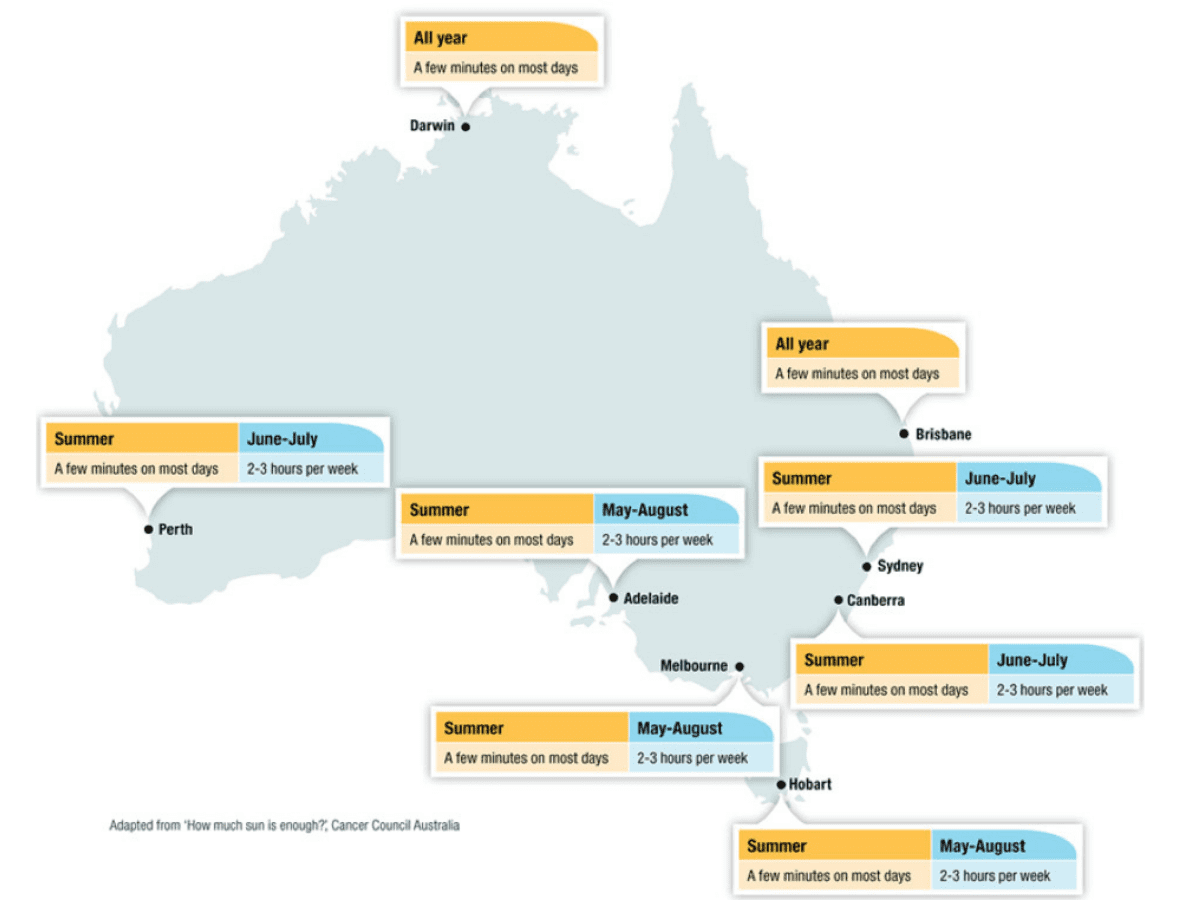
What You Need to Know About Vitamin D Deficiency in Australia
V
itamin D's Role in the Body
Vitamin D is essential for bone and skeletal health and helps to regulate calcium in the blood, yet Osteoporosis Australia reports that over 30% of Australian adults have some form of mild to severe Vitamin D deficiency. When vitamin D is obtained from the diet or sunlight reaching the skin, it is converted into calcitriol, the active form of vitamin D, primarily made in the kidney. Calcitriol's primary role in the body is calcium homeostasis maintenance.
Vitamin D sources
Sunlight
The best source of vitamin D for Australians is through bare skin exposure to ultraviolet B (UV) light from the sun. UV radiation varies depending on the season, location, and time of day, although the amount of sun required to reach adequate levels of Vitamin D is fairly low.
Food
Vitamin D can be obtained from a limited number of dietary sources including shitake mushrooms, liver, salmon, tuna, egg yolk, and foods fortified with vitamin D, such as bread and cereals. However, food alone cannot provide adequate levels of vitamin D.
Supplements
Vitamin D supplements are available for elderly people and those who are vitamin D deficient. Healthcare professionals can provide advice on which one to take based on your background and the type of medicine.
Vitamin D Deficiency and People Most at Risk
Australia has some of the highest levels of UV radiation in the world, yet vitamin D deficiency affects many Australian adults due to the amount of time spent indoors. Vitamin D levels frequently fluctuate during the seasons with the highest concentrations in summer and the lowest at the end of winter and early spring. Moderate to severe vitamin D deficiency can:
- Lead to soft bones (rickets)
- Lead to bone and joint pain
- Lead to osteoporosis and increase the risk of falls and bone fractures in older people
- Affect unborn children in vitamin D deficient mothers
People most at risk of vitamin D deficiency can have their level checked by a blood test. Those most at risk of having a vitamin D deficiency include:
- Elderly or housebound people
- Naturally dark-skinned people (the pigment in darker skin reduces UVB light penetration)
- People who avoid the sun for protection or medical reasons
- People who stay indoors for work reasons
- People who cover their skin for religious or cultural reasons
- People affected by medical reasons that can impact their ability to absorb vitamin D
- People taking medication that results in poor vitamin D absorption
- Babies and infants of vitamin D deficient mothers
- Obese people
- Pregnant or Post-Menopause women
Recommended Sun Exposure and Australian UV Map
Osteoporosis Australia recommends Australians to have a vitamin D level of at least 50 nmol/L at the end of Winter, while in Summer the level may increase to 60-70 nmol/L. The time required to spend in the sun to reach adequate vitamin D levels depends on your location, season, time of day, skin colour and the amount of exposed skin.
The Cancer Council does not recommend over-exposing skin to UV for people that are vitamin D deficient as too much sun exposure can lead to skin cancer. UV light increases throughout the morning and peaks at midday when the sun is highest. When the UV level reaches three or above, shade and sun protection must be used to avoid skin health issues. UV levels around Australia can be checked at MyUV. The map below from Osteoporosis Australia shows the recommended sun exposure time based on your location:
If you enjoyed reading this blog, consider joining our mailing list to ensure you are up to date with the latest health and complementary medicine news and information.
Lipa Pharmaceutical's Private Label range has three vitamin D products: Vitamin D 1000IU, Calcium and Vitamin D, and Calcium and Magnesium and Vitamin D.
By accepting you will be accessing a service provided by a third-party external to https://www.lipa.com.au/






